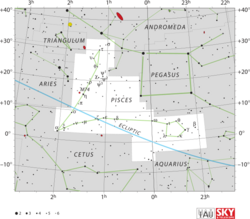Astronomy:Psi2 Piscium
| Observation data Equinox J2000.0]] (ICRS) | |
|---|---|
| Constellation | Pisces |
| Right ascension | 01h 07m 57.16387s[1] |
| Declination | +20° 44′ 20.8310″[1] |
| Apparent magnitude (V) | +5.56[2] |
| Characteristics | |
| Spectral type | A3 V[3] |
| B−V color index | +0.12[2] |
| Astrometry | |
| Radial velocity (Rv) | −15.2±0.9[4] km/s |
| Proper motion (μ) | RA: +86.72[1] mas/yr Dec.: −82.75[1] mas/yr |
| Parallax (π) | 21.14 ± 0.77[1] mas |
| Distance | 154 ± 6 ly (47 ± 2 pc) |
| Absolute magnitude (MV) | +2.19[5] |
| Details | |
| Mass | 1.82[6] M☉ |
| Radius | 2.0[7] R☉ |
| Luminosity | 13[3] L☉ |
| Surface gravity (log g) | 4.36±0.14[6] cgs |
| Temperature | 8,611±293[6] K |
| Rotational velocity (v sin i) | 149[3] km/s |
| Age | 250[6] Myr |
| Other designations | |
| Database references | |
| SIMBAD | data |
Psi2 Piscium (ψ2 Piscium) is a white-hued star in the zodiac constellation of Pisces. It is faintly visible to the naked eye, having an apparent visual magnitude of +5.56.[2] Based upon an annual parallax shift of 8.66 mas as seen from Earth,[1] it is located about 380 light years from the Sun. It has a peculiar velocity of 14.6±2.9 km/s, indicating it is a runaway star.[9]
This is a suspected binary star system,[10] with a companion star at an angular separation of 0.357±0.002 arc seconds along a position angle of 174.99°±0.30° from the primary, as of 2008. This corresponds to a projected separation of 16.88±0.62 AU.[11] The brighter component is an A-type main sequence star with a stellar classification of A3 V.[3] The system is a source of X-ray emission with a luminosity of 143.9×1020 W, which is most likely originating from the cooler companion since A-type main sequence stars are not expected to be magnetically active.[12]
References
- ↑ 1.0 1.1 1.2 1.3 1.4 1.5 van Leeuwen, F. (2007), "Validation of the new Hipparcos reduction", Astronomy and Astrophysics 474 (2): 653–664, doi:10.1051/0004-6361:20078357, Bibcode: 2007A&A...474..653V.
- ↑ 2.0 2.1 2.2 Høg, E. et al. (March 2000), "The Tycho-2 catalogue of the 2.5 million brightest stars", Astronomy and Astrophysics 355: L27–L30, doi:10.1888/0333750888/2862, Bibcode: 2000A&A...355L..27H.
- ↑ 3.0 3.1 3.2 3.3 Zorec, J.; Royer, F. (January 2012), "Rotational velocities of A-type stars. IV. Evolution of rotational velocities", Astronomy & Astrophysics 537: A120, doi:10.1051/0004-6361/201117691, Bibcode: 2012A&A...537A.120Z.
- ↑ de Bruijne, J. H. J.; Eilers, A.-C. (October 2012), "Radial velocities for the HIPPARCOS-Gaia Hundred-Thousand-Proper-Motion project", Astronomy & Astrophysics 546: 14, doi:10.1051/0004-6361/201219219, A61, Bibcode: 2012A&A...546A..61D.
- ↑ Anderson, E.; Francis, Ch. (2012), "XHIP: An extended hipparcos compilation", Astronomy Letters 38 (5): 331, doi:10.1134/S1063773712050015, Bibcode: 2012AstL...38..331A.
- ↑ 6.0 6.1 6.2 6.3 David, Trevor J.; Hillenbrand, Lynne A. (2015), "The Ages of Early-Type Stars: Strömgren Photometric Methods Calibrated, Validated, Tested, and Applied to Hosts and Prospective Hosts of Directly Imaged Exoplanets", The Astrophysical Journal 804 (2): 146, doi:10.1088/0004-637X/804/2/146, Bibcode: 2015ApJ...804..146D.
- ↑ Pasinetti Fracassini, L. E. et al. (February 2001), "Catalogue of Apparent Diameters and Absolute Radii of Stars (CADARS)", Astronomy and Astrophysics 367: 521–524, doi:10.1051/0004-6361:20000451, Bibcode: 2001A&A...367..521P.
- ↑ "psi02 Psc". SIMBAD. Centre de données astronomiques de Strasbourg. http://simbad.u-strasbg.fr/simbad/sim-basic?Ident=psi02+Psc.
- ↑ Tetzlaff, N. et al. (January 2011), "A catalogue of young runaway Hipparcos stars within 3 kpc from the Sun", Monthly Notices of the Royal Astronomical Society 410 (1): 190–200, doi:10.1111/j.1365-2966.2010.17434.x, Bibcode: 2011MNRAS.410..190T.
- ↑ Eggleton, P. P.; Tokovinin, A. A. (September 2008), "A catalogue of multiplicity among bright stellar systems", Monthly Notices of the Royal Astronomical Society 389 (2): 869–879, doi:10.1111/j.1365-2966.2008.13596.x, Bibcode: 2008MNRAS.389..869E.
- ↑ De Rosa, R. J. et al. (2012), "The Volume-limited A-Star (VAST) survey - II. Orbital motion monitoring of A-type star multiples", Monthly Notices of the Royal Astronomical Society 422 (4): 2765, doi:10.1111/j.1365-2966.2011.20397.x, Bibcode: 2012MNRAS.422.2765D.
- ↑ Schröder, C.; Schmitt, J. H. M. M. (November 2007), "X-ray emission from A-type stars", Astronomy and Astrophysics 475 (2): 677–684, doi:10.1051/0004-6361:20077429, Bibcode: 2007A&A...475..677S.
 |


